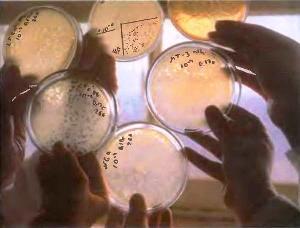
Before the onset of 2020, there were many forecasts of the development of new technologies in the twenties. As a rule, they all dealt with the problems of artificial intelligence (AI) and information technology in General (IT). But there are almost no publications about the BEGEN technology package (biology, engineering, genetics, eugenics, neuro). This abbreviation was introduced into scientific circulation by the guru of biotechnologies j. Metzl. It stands for biology, genetic engineering, eugenics, and neuroscience.
One of the reasons for the closeness of this issue is political and defense
This is directly addressed in the report of the Digital Disruption Innovation group of the Davos economic Forum (DEF), “deep technologies of BEGEN (biology, engineering, genetics, eugenics, neuro) as opportunities and threats” (under the overall direction of David Craig).
Since the second half of the 80 – ies of the last century, the most astute military thinkers have come to the conclusion that in the conditions of the ban of chemical and bacteriological weapons, the topic of at least limiting biotechnological developments, especially those related to changing the human genome, as well as creating fundamentally new fragments of the human genome that did not exist before, based on synthesis from living material, has risen on the agenda.
First of all this concerns the problems of gene weapons
The vast majority of publications not only in low-confidence Internet sources, but also in well-known media on the topic of genetic weapons are based on unverified facts, incompetent judgments and fake sensational news. For a long time, the media of all continents has been exaggerating information about the artificial creation of AIDS in American biological laboratories and the appearance of avian flu as a result of the leakage of biomaterials from Chinese secret gene enterprises.
At the same time, the very absence of serious research papers and investigations on this topic makes us suspect that relevant research is being conducted. Their secret nature is largely due to the fact that genetic weapons completely fall under the characteristic of biological weapons. In turn, biological weapons, according to the Geneva Protocol of 1925, and the biological weapons Convention of 1972, are strictly forbidden not only to use them, but also to develop them.
The fact that numerous documents were published already in the 90’s of the last century that irrefutably prove that, at least in the USSR, the United States, and probably in China before 1991, biological weapons were not just developed, but were at the disposal of special forces, and were taken into account in the military strategy and tactical deployment plans, leads to a skeptical mood regarding compliance with the ban on the development of genetic weapons.
The most reliable, although understandably one-sided, text on the use of genetic engineering for military purposes was published in 2019 by M. J.Ansco, Colonel of the armed forces of the United States under the heading, “next generation Bioweapons” to provide to Congress.
According to the author, gene weapons are currently being developed in China, North Korea, probably in Israel, Iran, and Russia. According to Swedish respectable media, the development of next-generation biological weapons is also underway in a number of NATO countries, primarily in the United States.
Einsko asks why, despite the huge destructive potential and the facts of use in the First world war, neither chemical nor biological weapons were used by the Nazis on the battlefield and in the rear during the Second world war.
Based on interviews with leading military historians, as well as experts in the field of biological and chemical weapons, he formulates the following conclusion, which is of a consensual nature. Because of their characteristics, chemical and especially biological weapons have much more unpredictable consequences in use than even nuclear weapons.
FIRST GENETIC WAR
An epidemic artificially caused in one country is highly likely to spread to a country that has used biological weapons. In addition, even suspicion of the use of biological weapons by one side of a military conflict can lead to their mass use by the other-the doubting party. De facto, the use of biological weapons will mean unleashing a global war without rules at all, moreover, a war that can continue after one of the parties is completely destroyed.
According to information obtained during the interview with Einsko, the first to reach such conclusions was JASON Group. The group, which has been active for more than 50 years, includes Americans on a voluntary basis-Nobel laureates in various fields of science – as well as outstanding researchers and scientists who have made recognized contributions to world science.
In 1997, the group, on its own initiative, presented a report to then-US President B. Clinton “on the threats of genetic engineering and high biotechnologies”. Thereafter, every five years, the group clarifies and supplements the basic report with specific examples and considerations.
The group identified five main areas of futuristic genetic and biological threats
The first direction is the development and use of dual biological weapons. Experts on weapons you know there is quite a long time a large part of the chemical weapons are produced and stored as binary weapons. Binary weapons consist of two capsules, each of which stores substances that are not weapons, and for the most part safe for humans. After making decisions about the use of chemical weapons, binary ammunition is mounted on carriers and launched towards the enemy. When an explosion occurs, the substances mix and become a deadly chemical. JASON Group suggested that due to the high reputational and sanctions risks associated with the production and storage, and especially the use of biogenic weapons, genetic engineers may well implement the binary principle during the production of bioweapons.
In this case, in peacetime, even if there are international inspections, it is possible to hide the fact of the production of biogenic weapons fairly reliably, and even more so to prove it legally.
The second direction is the development and use of modified genes. By the time the first version of the JASON Group report was written, the easiest and most accessible way to produce a gene weapon is to artificially amplify or change the genomic factors of traditional diseases.
According to the JASON Group, poor, technologically undeveloped rogue States like North Korea and Iran, or countries like Pakistan and India that have their own limited scientific and technological base, may be the first to develop such “genetic weapons for the poor”. This also includes terrorist organizations that are likely to be able to buy such biological weapons from rogue States. Life has shown the correctness of JASON Group’s forecasts. It was a modified version of anthrax that was discovered in the United States shortly after 11.09.01. Anthrax disputes were sent in envelopes to officials and the military in the United States.
JASON Group believed that this area is of little interest for technologically advanced countries, because they do not solve the main problem-the controlled establishment of limits for the use of genetic weapons. According to the report, genetic and biological weapons can be used EN masse if the scope of their use can be controlled and restricted.
The third direction is the creation of super fighters. Back in the USSR and the United States, starting in the 60s of the last century, as part of the implementation of space programs, extensive biomedical work was carried out to maximize the survival rate of the human body, depending on low – and high – temperature limit loads, increasing physical parameters in terms of running speed and duration of marches, lifting weights, etc.in the 80s of the last century, such work was deployed in Israel, and at the turn of zero-in China. JASON Group was confident that almost all biotechnologically developed countries of the world with serious armed forces will actively engage in what is called gene doping in sports, i.e., maximizing physical and neurophysiological abilities and capabilities.
The fourth direction is the creation of genetic and biological weapons of limited damage. Since the main drawback of biological weapons is the uncontrolled nature of their use and distribution, JASON Group considered the creation of limited gene weapons to be the main direction for improving biogenic developments. According to them, technologically advanced States will strive more and more to create such viruses by genetic engineering and synthetic biology that would not threaten the soldiers and officers of the enemy’s armed forces with a lethal outcome or serious diseases.
Back in 2002, the JASON Group suggested that the future of biogenic weapons is to be used in hybrid and proxy wars. In itself, biogenic weapons should have a kind of hybrid character. It is intended to hit enemy combatants and non-combatants, but only temporarily disable them, or significantly reduce their ability to conduct combat operations or work in the rear. For example, epidemics of colds, stomach disorders, headaches, toothaches, etc. they can dramatically limit the combat capability of the enemy and, in fact, disable its advanced special forces for a certain period of time. This is the direction that JASON Group suggested focusing on.
The fifth direction is the development and production of ethno-oriented biogenic weapons. The prevailing view in official genetics to this day is that it is impossible to create and use biogenic weapons aimed at specific groups of the population, separated by national, racial and other characteristics. Meanwhile, in recent years, top-level leaders in the field of national security – the Director of National intelligence, d. Klepper and the Secretary of the Russian Security Council, Nikolai Patrushev, talked about the possibility, and indeed the real danger, of developing and using genetic weapons aimed at certain groups of the population.
DEF experts believe that in the dispute between official geneticists and high-ranking politicians, it is the politicians who are right. Indeed, a biogenic weapon that affects the citizens of one country and is harmless to the citizens of another cannot be created. Citizenship is not a biological category, but a legal one. Gene weapons of any degree of rigidity-from causing mild illness to causing death – can be targeted at any group that has specific genetic markers. If a marker that allows you to select a group exists, then a genetic biological weapon of any power and intensity can be created. And if it doesn’t exist, it can’t.
As of today, it is known that biogenic markers exist for representatives of different races. It should be noted that the presence or absence of such a marker is a statistical category and can not be specified for each individual in all cases. Given example. More than 80% of the Negroid race, in comparison with the white race, are more resistant to malaria caused by Plasmodium vivax, if their red blood cells do not have Duffy AG, which is a receptor for parasites. On the other hand, people from Africa are 10 times more likely to develop disseminated coccidioidomycosis than Europeans.
According to research done for the leadership of the Indian armed forces, it is quite possible and even more likely, in the period up to 2025, the creation of biological weapons of mass destruction, which can systematically destroy any human populations specified by key genetic characteristics, will become quite possible. Its damaging elements are artificially created microorganisms (pathogens), including strains of bacteria and viruses modified using genetic engineering technologies that can instantly cause diseases and negative changes in the human body. It can be used to cause changes in the heredity, metabolism, or behavior of millions of people.
Genetic weapons of mass destruction have the ability to instantly destroy an entire race
About the realism of the creation of genetic weapons is confirmed by the fact that the scientific centers of some countries, e.g. USA, are engaged in acquisition of genetic information on the population of different regions, especially those where there are American interests or located countries or having a better chance of becoming enemies of the United States (the authors of the report DEF believe that the reasons for buying are not related to the development and production of ethnically targeted biogenetic weapons of the United States. However, a number of leading media with a serious reputation make this hypothesis).
Probably for the same reason, China has legally banned the provision of data on the genomes of Chinese citizens by medical institutions or biotech firms. Also, according to Chinese law, foreign pharmaceutical companies do not have the right to independently conduct clinical and preclinical drug tests with the collection of laboratory data outside of China.
According to the findings of the JASON Group, the Defense threat reduction Agency (DTRA) of the U.S. government is called upon to conduct annual intelligence monitoring regarding the possibility of developing, and even more so, the production of biogenic weapons, and if such a threat is detected, immediately report to the Secretary of defense and the President on the highest level of threat to America. Although DTRA is responsible for intelligence and countering the development, production, and use of weapons of mass destruction, including biological weapons, and has huge amounts of funding, it is little known in the United States. Moreover, most directories do not include it in the list of intelligence agencies.
Currently, thanks to the report of the head of the Agency to one of the congressional commissions, it became known that the Agency sees the main threat of using biogenic weapons against the US population either in terrorist acts using genetically modified viruses modeled on anthrax in the early noughties, or through destructive modification of food coming to certain States of the country from Latin American countries. As noted in the Agency’s materials, ” in the modern world, countries with a low level of food and drug security are defenseless against biogenic weapons, including relatively simple samples made by terrorists or ordered by underground biogenic laboratories.”
Laws against gene weapons
The situation with the legislative regulation of genetic engineering and synthetic biology is extremely uncertain and ambiguous. On the one hand, out of 192 UN member States, almost 40 countries (almost all of them are technologically advanced) have already banned or are preparing to ban genetic modification of the germ line. In particular, such bans are available in most European countries, as well as in Canada and Australia.
As for the UK, the situation is different. In the summer of 2018, the British Council on bioethics recognized genetic modification of infants as acceptable, making a reservation that it “can only be ethically acceptable if it is carried out in accordance with the principles of social justice and solidarity”. At a parliamentary hearing in 2019, leading representatives of the scientific community said that if the Johnson government liberalizes legislation on editing the human genome within 20 years, such services could become the first item of state revenue.
The situation is ambiguous in the United States
America together with China are two of the undoubted, far detached from others, leaders in the field of genetic engineering. In the emerging field of synthetic biology, Americans have no equal. At the same time, in the United States, there is a ban By the us food and drug administration (FDA) on the use of human embryos deliberately created or modified for research on inherited genetic modifications.
At the same time, science, business and law enforcement interpret this ban narrowly, meaning as of the end of 2019 only the ban on the creation of designer children, as well as research in the field of new eugenics. As for the use of genetic engineering and synthetic biology for the pharmaceutical industry and as a substitute for operational problem solving, it is not interpreted as genetic. It also has nothing to do with genetic scanning of embryos in the case of IVF. In addition, it should be borne in mind that Americans not only go to neighboring border Mexico to perform IVF, but also to conduct genetic and embryonic research. Numerous startups in the field of medical and eugenistic genetic engineering and synthetic biology place their headquarters and research laboratories in Mexico, Costa Rica, and Panama, where there are no restrictions in the field of genetic engineering and synthetic biology.
China also has a very ambiguous position
Bans are primarily ethical and moral in nature and relate mainly to private programs and research. The fact that the vast majority – up to 95% – of all patents and publications in the field of genetic editing and synthetic biology fall approximately equally on the US and China, underscores the fact that in fact both countries are actively developing this kind of research and development, primarily at the state level, and the strictest control is exercised over the private sector.
In fact, India, South Korea, and the Philippines and Indonesia provide very broad opportunities for gene editing and synthetic biology.
The world summits on genetic engineering held in 2015 and 2018 generally negatively assessed any attempts to use genetic engineering for eugenics and were wary of synthetic biology.
At the second summit on editing the human genome, held in late November 2018 in Hong Kong, on the one hand, participants condemned the acceleration of work on editing the human genome, and on the other hand, they appealed to all research groups dealing with this topic to share their experience and share results.
In General, the situation with national and international legislation on genetic editing and synthetic biology is similar to the situation in another area – the field of artificial intelligence. Although the consequences of gene editing and synthetic biology are orders of magnitude more explosive and pose more serious risks and threats to humanity, in both cases there are not even the outlines of international legislation.
In the field of genetic engineering and synthetic biology, there are an order of magnitude more players than not only in the field of atomic weapons, but also in the field of artificial intelligence. In this area, geostrategic, medical, socio-political, and investment problems and issues have created a snowball-like tangle of contradictions.
As for specialists, it is obvious that they need to develop common international legal principles that regulate genetic engineering, define its goals and establish a system of strict international monitoring of products, technologies and personnel in this area.
DEF experts believe that such a regulatory framework should include at least:
– criteria for use of genetic modification;
– restrictions on genome editing purposes;
– mandatory availability of reliable preclinical and / or clinical data on risks and threats to human health and embryos, which may open the possibility of targeted genetic modification to eliminate them;
– development and implementation of all-inclusive permanent international monitoring of scientific research, clinical trials, technological operations, as well as equipment, programs, biological materials, etc., necessary for carrying out work on human genetic editing and synthetic biology;
– introduction of an international research passport for persons engaged in research and development in the field of state and commercial use of human gene editing technologies and synthetic biology, and, accordingly, conducting comprehensive monitoring of the professional activities of holders of such diplomas.
These are the minimum requirements
However, it seems highly unlikely that they can be fully or even partially reflected in an international legal instrument.
In the conditions of tectonic technological, serious socio-political shifts and economic instability, there are processes of abandonment of previously signed international agreements, as well as there is no will and initiative to sign new documents on the legislative limitation of risks and threats facing humanity in the twenties.





















